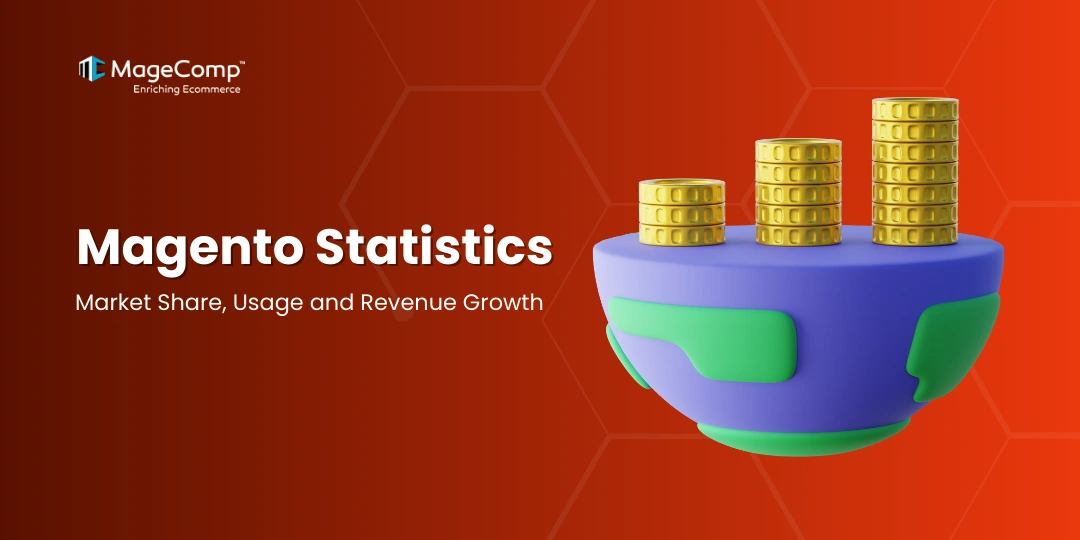Magento Statistics (2025) – Market Share, Usage and Revenue Growth
Magento is an open-source PHP-based eCommerce platform that was initially launched in 2008 by Varien Inc. Its flexibility, scalability, and extensive customization options made it achieve high popularity among businesses of all sizes.
After a decade, in 2018, Adobe acquired Magento and integrated it into Adobe Experience Cloud, enhancing its ecosystem with AI-powered insights and personalization. So, it is 14 years now, and Magento still amazes every eCommerce admin with its amazing customisations.
Magento is a platform that enables businesses to build robust eCommerce stores with multiple features like shopping carts, product management, marketing tools, and, of course, payment processing. Magento Open Source (free) and Adobe Commerce, formerly Magento Commerce, is a premium version offering advanced features like AI recommendations and cloud hosting.
In this article, we have gathered some insightful stats and facts about Magento and its usage, market share, and much more for 2025.
Timeline of Magento
Before moving forward with the insights, let’s take a look at the history of this fascinating eCommerce platform.
As we discussed above, Magento was officially launched in 2008, but it was co-founded by two Varien Inc. employees, Yoav Kutner, and Roy Robin, and was initially released on 31st August 2007.
Over the past 17 years, the Magento ecosystem has undergone significant transformations marked by pivotal events that have shaped its journey. Beginning with its acquisition by eBay, Magento experienced a new phase of development and growth, further culminating in a groundbreaking billion-dollar acquisition by Adobe.
This timeline highlights the evolution of the Magento platform from its inception in 2007 to the present day, showcasing the major milestones and advancements that have contributed to its status as a leading e-commerce solution.
| Year | Events |
| 2007 | Magento’s beta version was born. (31-08-2007) |
| 2008 | The platform’s first stable version, the Magento community edition, was launched in June 2008 |
| 2009 | Magento launched its enterprise edition released in April 2008 |
| 2010 | The parent company, Varien Inc. renamed its osCommerce platform as “Magento”. |
| 2011 | eBay became the owner of Magento by acquiring 100% shares of Magento Developer Certifications. |
| 2012 | Magento achieved a new record of 4 million downloads. |
| 2015 | Magento Commerce started as its own company, supported by the Permira Funds. Magento 2 was launched on November 17, 2015. |
| 2016 | Magento’s first theme, Magento Luma Theme, was released. Magento Marketplace and Magento Enterprise Cloud Edition were launched. Magento platform partnered with Adobe. |
| 2017 | Magento Community Edition became Magento Open Source, and Magento Enterprise Edition became Magento Commerce |
| 2018 | Adobe officially acquired Magento in August 2018 |
| 2019 | Adobe Commerce Cloud and Amazon Sales channel were added to Magento. |
| 2021 | Magento Commerce was rebranded as Adobe Commerce. |
Adobe Commerce General Statistics
- Adobe Commerce (Magento) is one of the top eCommerce platforms preferred by business admins.
- As of October 2024, 120,947 live Magento websites on the Internet and 366,747 domains are redirected to the websites in this list.
- The majority of eCommerce stores using Magento have recorded three times faster growth in this platform compared to other eCommerce platforms.
- Adobe acquired the Magento eCommerce platform for $1.68 billion in 2018.
- As per Internet Retailer B2B 300, Magento is the No.1 eCommerce platform.
- Transactions worth $155 billion are recorded annually by Magento.
- Over 3890 Magento extensions are offered by the Magento community.
- Approximately 200 Magento stores are on the list of top 1000 eCommerce retailers.
- There are nearly 482,820 Magento open-source community members on the official Adobe forum.
Magento Usage Statistics
- The United States has the highest number of Magento users, followed by the United Kingdom, Netherlands, and Germany.
| Countries | Magento | Shopify | WooCommerce |
| United States | 39,541 (34.04%) | 2,856,231 (57.66%) | 2,480,339 (41.17%) |
| United Kingdom | 9,097 (7.83%) | 194553 (3.93%) | 233505 (3.88%) |
| Netherlands | 8080 (6.95%) | 56460 (1.14%) | 131170 (2.18%) |
| Germany | 7319 (3.31%) | 125490 (0.89%) | 165657 (2.29%) |
| Italy | 3,849 (3.31%) | 43,823 (0.89%) | 138,084 (2.29%) |
| Brazil | 3,573 (3.07%) | 118,789 (2.40%) | 147,652 (2.45%) |
| France | 3,487 (3.00%) | 72,894 (1.47%) | 153,204 (2.54%) |
| Australia | 3,314 (2.85%) | 142,382 (2.88%) | 119,558 (1.98%) |
| Spain | 2,843 (2.45%) | 25,727 (0.52%) | 118,238 (1.96%) |
| India | 1,848 (1.59%) | 78,411 (1.58%) | 186,828 (3.10%) |
- The top categories for Magento websites are diverse, with furniture leading at 2,252 sites, followed closely by fashion at 2,069 sites, and shoes at 1,552 sites.
| Furniture | 2,253 |
| Fashion | 2069 |
| Shoes | 1552 |
| Groceries and Food | 1458 |
| Bags | 1414 |
| Pharmacy | 1249 |
| Electronics | 1228 |
| Jewellery | 1172 |
| Alcohol | 1167 |
| Kitchenware | 1064 |
| Bedding and Bathroom | 946 |
| Apparels | 858 |
| Women Clothing | 759 |
| Nutrition | 756 |
| Fitness | 714 |
- Magento is the third most popular eCommerce platform, following Shopify and WooCommerce.
- Over 240,000 live Magento websites are being used globally.
- The Magento Open Source platform has surpassed 2.5 million downloads.
- Harborfreight.com is the leading Magento site and is one of the most popular tool retailers in the US, with 40 million visitors per month.
- Magento eCommerce is the top preference of more than 20,000 small-scale businesses.
Magento eCommerce Statistics
Magento primarily consists of two main categories: Open Source (commonly referred to as Magento Community) and Magento Commerce (known also as Magento Enterprise). In recent years, retailers have utilized these e-commerce platforms to create their online storefronts and gain a competitive advantage in the market.
Here are some key statistics regarding Magento as an e-commerce solution that you ought to be aware of.
- As reported in the Magento Year in Review, 46% of users access Magento websites via mobile phones, 43.3% use desktop computers, and the remaining users access through tablets.
- 61% of Magento online stores provide a phone number on their site, while 51% include email addresses for contact purposes.
- 9.3% of Magento stores are focused on selling Home and Garden items, 6.4% on clothing products, and 5.1% on business and industrial goods.
- 13.4% of Magento stores are located in the United States, 6.5% in the United Kingdom, and 6.1% in Germany. The Netherlands is home to 5.4% of Magento stores globally.
- Around 1365 vendors have contributed 5,731 Magento extensions in the Magento App Store, and the number is constantly growing.

Magento Growth Statistics
Even though losing the top spot to other eCommerce and CMS platforms, Magento’s market share has seen steady growth along with occasional downfalls.
Let’s examine some important statistics regarding the growth of Magento’s market share.
- Magento’s market share has risen by 300% since 2018.
- In the last fiscal year (2023), investors in Magento experienced a 29% increase in platform revenue and a 247% return on investment over three years.
- In 2023, Magento reportedly achieved 67% faster development of new features.
- During the fourth quarter of 2023 (Q4), the number of Magento stores rose by 5.9% compared to the previous quarter (Q3).
- Magento stores saw a 25% year-over-year increase in Q2 of 2024.
Magento 1 Vs. Magento 2 Statistics
The primary distinction between Magento 1 and Magento 2 is that Version 2 offers improved speed, enhanced SEO capabilities, and a more user-friendly experience compared to Version 1.
Additionally, Magento 2 is compatible with the latest PHP versions, which boosts the overall performance of the site. Now, let’s examine how these two versions compare in terms of statistics.
- Currently, 91,177 online stores are operating on Magento 2, in contrast to 148,282 users utilizing Magento 1 for their online shops.
- Magento stores can process 500 transactions each hour, whereas Magento 2 stores can manage 600 transactions in the same timeframe.
- Of the Magento 2 websites, 25.38% are e-commerce sites, while 3.53% fall under the arts and entertainment category.
- Magento 1 provides superior flexibility and features, while Magento 2 excels in performance and offers a more intuitive interface experience.
- The annual cost for a Magento enterprise edition license is approximately $18,000, while the price for a Magento 2 enterprise edition is around $22,000.
Magento Security Statistics
Magento is favored by merchants globally for their e-commerce websites, which makes it a prime target for hackers and cybercriminals. Let’s examine some important security statistics related to Magento in recent years.
- Magento experiences 0.71% of attacks, while WordPress encounters the highest percentage of attacks at 95.6%.
- In 2020, over 500 Magento websites were compromised in a payment skimmer incident.
- In 2022, Adobe and Magento stores experienced an increase in cyber attacks aimed at the vulnerability CVE-2022-24086, which is a significant mail template vulnerability.
- In June 2024, the CosmicSting vulnerability impacted 75% of Adobe Commerce and Magento websites.
Magento Marketing Statistics
Magento sites typically utilize various technologies for marketing, data collection, and advertising. The statistics for Magento 2 include the following:
- 3,070 Magento sites are employing Google Optimize 360 for their activities.
- 24,542 Magento websites are utilizing Google Conversion Tracking.
- Google Remarketing is beneficial for 31,072 websites built on Magento.
- Magento stores also leverage third-party tools for data collection:
- 50,782 websites are using Magento 2, Google Analytics 4,
- 271 websites are utilizing Google Analytics Ecommerce and
- 2,474 websites are taking advantage of Google Analytics Enhanced Ecommerce.
- Google AdSense is operational on 3,681 Magento websites.
- Additionally, 68,370 Magento sites are making use of Google Maps.
- The Microdata for Google Shopping tool aids 28,761 Magento websites.
- Regarding email marketing, 2,449 Magento websites employ Marketo Mail.
- 11,568 Magento sites utilize MailChimp, with 3,962 websites using MailChimp SPF.
- 1,958 Magento websites are making use of MailJet.
- Lastly, 173 Magento websites utilize Constant Contact Mail.
Interesting Facts About Magento
The statistics outlined earlier provide a clear understanding of Magento’s standing in the present market. Nonetheless, some intriguing, lesser-known details about Magento may catch your interest.
- A remarkable 99.9% of Magento’s development took place in Ukraine.
- In 2016, Magento reached its highest level of popularity. However, since then, online searches related to the Magento platform have been declining, indicating a downward trend in its fame.
- Originally, the platform was intended to be named “Magenta,” inspired by the color. However, due to the unavailability of the magenta.com domain, the co-founders opted for the name “Magento.”
- The name and logo of Magento were influenced by the popular game Dungeons and Dragons.
- While the default configuration of Magento lacks any extensions, there are more than 5,000 extensions available to cater to your online store’s requirements.
- Estimates suggest that the Magento platform can yield significant profits for a company within 5.2 months following the completion of the setup process.
- Every year, Magento processes over $100 billion in gross merchandise sales.
- The name Magento is frequently misspelled as “Magneto,” which is a character from the Marvel Comics universe. Interestingly, even Adobe documentation sometimes misspells it.
- Magento is accessible in over 30 languages, including Farsi, Norwegian, Estonian, and Thai.
Final Say
Recent statistics indicate that Magento maintains a significant presence in the e-commerce market, ranking as the third-largest platform worldwide in terms of usage distribution. While its popularity has seen a decline since its peak in 2016, it continues to be a strong choice for thousands of brands across the globe, showcasing its enduring potential.
One of Magento’s key advantages is its extensive support for a variety of third-party integrations, which allows businesses to customize their online stores to meet specific needs. Moreover, Magento has exhibited a consistent rate of growth in recent years, making it a reliable option for those looking to develop an e-commerce website.
If you’re considering building an online store, Magento certainly deserves your attention as a robust and versatile platform. Contact us and get your Magento store ready to soar the eCommerce market.
Sources: Statista, Magento Community, Reddit, Adobe, Built With
More Statistics Blogs





